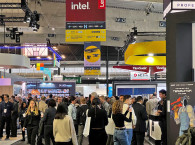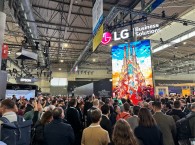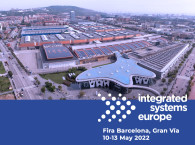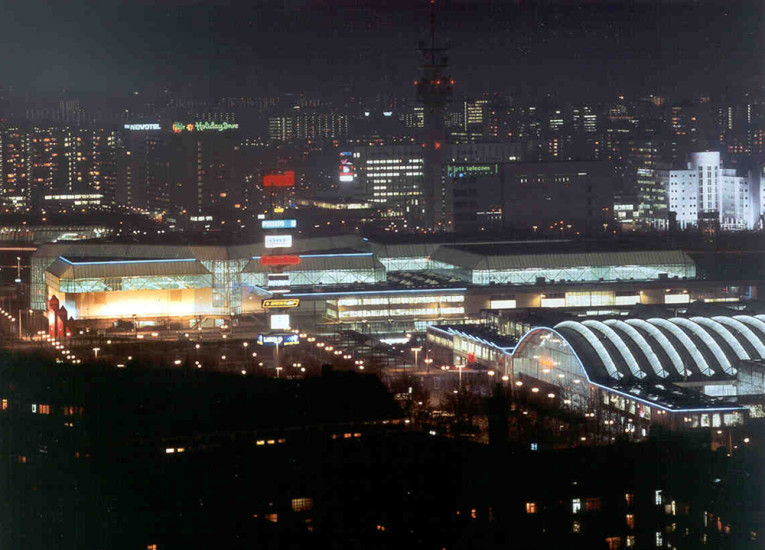
The announcement was in fact scooped by a Catalonia newspaper, breaking the embargo in place and forcing Integrated Systems Events to anticipate the publication of the press release. No wonder, since this was major news for the city of Barcelona, given the size of the event and the potential economic impact to the region (not to mention its political significance).
The official presentation ceremony - for which I was invited to attend together with an impressive number of colleagues from other AV publications from all over the world - took place at the Barcelona historical Saló de Cent, or the Great Hall of the City Council, on July 19. This allowed a broader picture for the move of what is internationally regarded as one of the most successful and fastest growing trade shows in the industry and globally.

The press conference was held with formal announcements from (left to right in the photo) Mike Blackman, Managing Director Integrated Systems Events, Constantí Serrallonga, Director of the Fira de Barcelona, Àngels Chacón, the Minister for Business and Knowledge for the Catalan Government, Ada Colau Ballano, the Mayor of Barcelona, Tabatha O'Connor, CEO of CEDIA, and David Labuskes, CEO of AVIXA.
Following a Q&A session, the press and many of the members of the ISE Board of Directors and Advisory Board, which includes representatives from some of its longest supporting exhibitors, were invited to tour the Fira de Barcelona Gran Via complex. This modern venue, which also hosts the GSMA Mobile World Congress every year, will become the permanent location for what is now the world's largest AV and systems integration show.
From the executive speeches and many of the conversations with the directors and advisory board members, we learned that ISE has been looking for a solution for its future expansion for a few years, and that Barcelona has been always one of the strongest candidates. As Mike Blackman stated, the decision to relocate the ISE exhibition was taken after research concluded that remaining at the RAI Amsterdam was no longer an option, given the show's annual growth in exhibitors and attendees (10% every year). The decision to support the move to Barcelona was taken unanimously by the ISE Board, confirmed Blackman. Research among exhibitors and attendees also confirmed that Barcelona was the destination of choice for dining, entertainment, hotels, and lodging.
It's important to have some perspective about this. ISE 2018 attracted 80,923 attendees, of which 22,000 were visiting the show for the first time while 1,296 exhibitors filled 53,000 net sqm of floor space in 15 halls. ISE 2019 is expected to increase on these record-breaking figures, and at least 5% growth is expected again for 2020, the last edition in Amsterdam. To accommodate that growth, the RAI Amsterdam is currently working on expanding the complex with another hall, but ISE already requires the construction of at least four additional halls, until 2020. In comparison, the Gran Via complex in Barcelona, has 240,000 sqm of floor space in just eight halls. Halls 2 and 3 of the Fira complex alone (32,000 and 43,000 sqm, respectively) could accommodate ISE as it stands today.
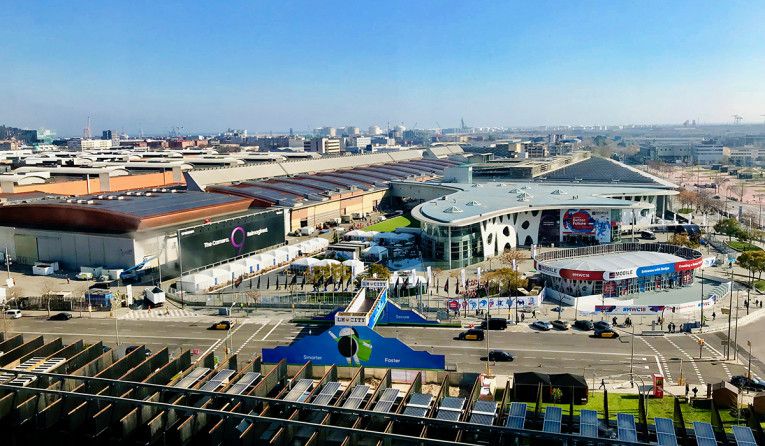
I have visited the Fira de Barcelona Gran Via complex in the last few years, attending the GSMA Mobile World Congress, which is the largest show held in the city, with 108,000 visitors, and 2,400 exhibiting companies, basically occupying the complete Gran Via complex and many other spaces in the city, including the old Fira Montjiuc complex. Independent economic analysis indicates that MWC contributes with approximately 471 million Euros ($580 million USD) and more than 13,000 part-time jobs to the local economy. Blackman and the Mayor of Barcelona revealed they expect an impact of nearly $400 million Euros from ISE, which is held just three weeks before MWC.
The challenge for ISE will be to keep the growth momentum over the next two years while planning takes place to take it to a whole new level, which will need to be promoted in completely new ways by the two founding associations, the Audiovisual and Integrated Experience Association (AVIXA), producer of InfoComm, and the Custom Electronic Design & Installation Association (CEDIA). In my opinion, they will need to reach out to other industry associations from other systems integration segments.
Integrated Systems Events is a company owned by AVIXA and CEDIA, but the ISE show has long outgrown the scope of the promoting parts and is now a very global event. In order to leverage its full potential, ISE might in fact have to embrace its global scale. Not surprisingly, during the press conference one of the Spanish journalists asked if the event would change its name, dropping the "Europe."
This is also the reason why Blackman is visibly committed to cooperate with the Fira de Barcelona and the local authorities in creating new synergies to foster further growth, which might include expanding the current B2B focus of the show to also attract more final users and local companies. But the challenge remains to understand the reason why ISE was so successful in the first place and not lose track of its roots.
With the move to Barcelona there is no doubt in anyone's mind that the visitor profile will change. The convenient Amsterdam central location was strategic to attract large technical teams from many system companies and integrators from Germany and all central European countries, who were able to send more staff to visit at least for two days. Reaching the Netherlands by car or train allows visitors to stay one night and return at the end of the second day. With Barcelona depending mostly on air travel this will undoubtedly change. Companies will carefully select who gets to attend, given the extra traveling costs.
That's why expanding the scope of the show from a pro-AV focus more into complete Systems Integration will be crucial. It was never clear which market segment propelled ISE to its growth from its modest roots in 2004, but Integrated Systems Europe completely surprised its promoters.
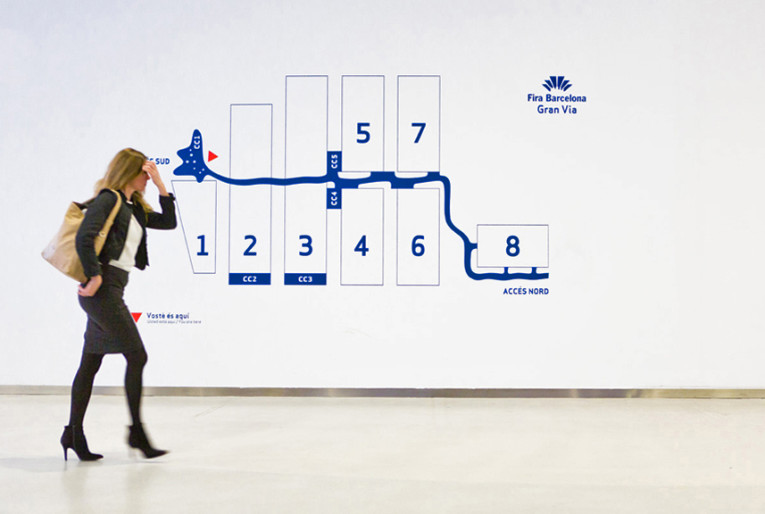
I started reporting on Integrated Systems Europe during its first event in Geneva, and I attended the second edition already in Amsterdam, the third edition in Brussels in 2006, and the return to Amsterdam in 2007, where it has remained until now. The 2006 edition in Brussels made it clear why the show was needed, allowing for audio, video, home automation, and security, among other system integration segments to converge and expand. Many early ISE exhibitors transitioned from shows like Prolight+Sound or Cebit in Hannover, following several attempts by InfoComm to promote its own events in Europe. The whole idea to promote "Integrated Systems" events (at the time both in Europe and Asia) was born from the joint efforts of CEDIA, InfoComm International, and the National Systems Contractors Association (NSCA) - just as the NSCA renamed its own event in Las Vegas, NV, as "Systems Integration Expo," merged directly into InfoComm the following year.
In 2006, in Brussels, ISE received more than 10,000 professional visitors and 330 exhibitors, growing 50% in relation to the 2005 show. The main attraction for ISE 2006 was the emerging digital signage segment, video communications and conferencing and the first collaboration systems - at a time when the AV industry was embracing HD presentation systems and the convergence of AV over IT.
In 2008, already in Amsterdam, the show consolidated its position as the leading trade show for the integration industry. From 16,269 visitors and 363 booths in 2007, the show evolved to 22,199 visitors and 481 exhibitors. Blackman reminded the press then that ISE 2008 was 10 times the size of the original Geneva show, four years past. The show lasted only three days, and many visitors were shocked to find out the show was closing earlier in the third and final day while they still had much to see. Professional integrators from all areas marveled at the possibility of finding cabling, distribution, control, and all the hardware and software they needed for their systems. Home automation and IP infrastructure solutions were attracting a new class of professionals, companies in building automation, architects, office designers, IT managers, and many others never before seen in pro-AV shows.
Displays and projectors were still taking most of the exhibition space, but it was clear that many companies were meeting new competitors and partners for the first time. The fact that lighting control manufacturers and lighting industry consortiums decided to attend ISE was also a clear indicator that this was a show that would grow quickly. Exhibitors in general declared that ISE was the show to meet actual project managers and key project specifiers in areas that had not met before, like public spaces, buildings, and corporate installations. Audio manufacturers who attended, quickly understood the opportunity and expanded their offerings to embrace the growing installation opportunities in all applications segments. This caused a major migration from other more entertainment-oriented events and encouraged manufacturers to invest more in product areas that were until that time considered "not particularly exciting."
But perhaps the most surprising aspect was the fast transition from a show dominated 90% by traders to a complete program that currently attracts more and more end users and specifiers, almost half of the current visitor profile. Over the last two years, ISE not only has outgrown the Amsterdam RAI but its own success attracted many new players from other industries.

As Blackman confirmed, there is a waiting list for new exhibitors, and existing exhibitors want to build larger stands. But more importantly, there are new areas of growth for the show that ISE was not able to accommodate in the past - networking, security, smart building and smart home technologies make complete sense within the show concept. Another key area that was never able to expand, even though its presence was clearly felt in ISE's expansion over the last years was that of lighting technologies, a key component in building and home automation, and obviously a key component in any AV installation.
So, there's plenty of opportunity for ISE to expand in Barcelona and become twice what it achieved in Amsterdam so far. Will it remain on track to grow that much with the move to Barcelona? That is the challenge. As Blackman stated during the press conference, the focus for the move was on providing a better show experience for exhibitors and visitors. But now there will be obviously the opportunity to expand to other sectors and create a better layout which will enable visitors to make their time more effective, knowing that it is impossible to see everything, even in four days.
ISE has in fact only expanded from a three-day to a four-day trade show in the past two years. It is obvious that when a show expands and needs to accommodate extra visitors, one of the solutions is to spread the duration of the show, and hence dilute the crowds. But ISE has continued to struggle with an imbalance from the first two days, where crowds at the RAI became overwhelming, to the fourth day, where many exhibitors have questioned if it is worth it - 12,000 and 18,000 visitors attended the last day in the last two years, respectively. With higher costs in traveling and probably in hotels (judging from what happens at MWC, this is almost certain), visitors in Barcelona will also tend to spread more uniformly during the four days. Also, the appeal for visitors from the Americas and Asia will only increase, judging from the trend in the last few years. Barcelona will certainly encourage more visitors to spend more time in the city - even if the weather there in February has proven somewhat unpredictable, with heavy rain causing havoc at critical commuting hours.
ISE's own success will also represent a major challenge for AVIXA's InfoComm and CEDIA's own shows in the US, which will tend to be perceived increasingly as "domestic" events.
Finally, the elephant in the room for this move to Barcelona - and a topic carefully avoided by all parties during the press conference - was the political instability that still affects the region with the recent uprising of the Catalonian independentist movements.
For Integrated Systems Events and the respective shareholders, the move to Barcelona was a brave decision that no doubt will be rewarded by the local institutions, while at the same time casting uncertainty over the entire initiative in years to come. The GSMA, promoters of the Mobile World Congress have learned this too well and were this year forced to work on contingency plans. But as Blackman reinforced, "Integrated Systems Europe is here for business." The support from the local entities, the city council, and the local government was very visible in the way it welcomed and supported the event. As the city mobilized to support MWC, I have no doubt that ISE exhibitors and visitors will feel welcome.
www.iseurope.org | www.avixa.org | www.cedia.net
This article was originally published in our weekly newsletter The Audio Voice.
Register here to receive it every week: http://bit.ly/1ri0b4J




